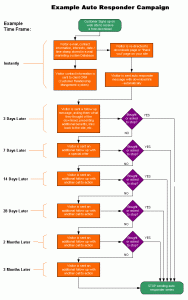It’s time to clean up that account clutter! Columnist Matt Umbro offers steps for prioritizing your workflow to make the biggest impact and improve performance.
 Client relations can sour for a number of reasons. Perhaps performance is lagging or communication isn’t clear. Whatever the reason, more often than not, poor client relations result from the account manager’s inability to present and execute a viable strategy.
Client relations can sour for a number of reasons. Perhaps performance is lagging or communication isn’t clear. Whatever the reason, more often than not, poor client relations result from the account manager’s inability to present and execute a viable strategy.
Simply put, if the work process and deliverables are suspect, clients are going to be wary. That’s why, as account managers, we need to better prioritize our workflow in order to make the most impactful optimizations.
Whenever I speak with clients about new or ongoing initiatives, my number one thought is whether the potential impact will be worth the time spent. In other words, is the effort worth the reward?
There are only so many hours in the workweek, and some of us have many clients. Focusing too much on tasks that may only slightly move the needle is prohibitive to running a successful account.
We can argue which tasks are going to make more of an impact, but again, it goes back to using your time effectively. One of the most common examples in paid search is the creation of shopping and text ad campaigns.
Shopping campaigns tend to need less setup time, better prequalify the audience (since we are showing image and price) and will show for more queries. Though important, text ad campaigns take longer to set up, and, depending on the niche/product, will receive far less traffic than their shopping counterparts.
Thus, it’s more beneficial to first set up shopping and then move to text ads, or at least only create text ad campaigns for the top themes.
It’s this type of thinking that account managers need to be aware of and even push back on with clients. Part of doing great work is bestowing confidence.
If you are wary of an initiative’s impact and believe something else is more important, you need to share your thoughts. Your suggestions may be declined, but clients appreciate your willingness to draw from your experience and explain a competing path.
So how can you go about better prioritizing your efforts? The first step is to audit your existing workflow.
Review All Tasks And Condense
I would venture that we all conduct tasks that have little or no impact but take up precious time. I find that the top three culprits are time spent on:
- Reporting
- Presenting work
- Running tasks manually that can be automated
As an example, I update my reports on a consistent basis to improve efficiency. These updates may involve removing sections, pulling data differently to shorten the process or automating sections.
Here is where self-confidence comes into play. If you believe the report to be too cumbersome, and certain sections aren’t providing value, don’t be afraid to make changes.
The same philosophy applies when presenting work. Clients don’t need to see every bid change you’ve made or ad you’ve created.
I’m exaggerating a bit, but the philosophy is that as long as you are trustworthy, reliable and providing good results, it’s okay to only show clients the most important updates.
Finally, see where you can automate tasks, or even delegate. We’ve already touched on reporting, but there are many free and paid tools that can save you time.
Furthermore, tools don’t have to make changes, but rather, can alert you when necessary. For example, both Google AdWords and Bing Ads allow you to receive emails when thresholds are met (e.g., a keyword has seen 100 clicks and 0 conversions over the last seven days).
Through this audit, you are removing the clutter from your daily routine, which allows you to focus your time where you can make more meaningful optimizations.
Think Expansion
The ultimate goal of every account is not just to see better performance, but to do so while continuing to grow. If accounts aren’t growing, performance plateaus and client relationships can become stale.
It’s your obligation to foster and prioritize an environment where new ideas are welcome and consistently being tested.
That’s why it’s so important to cut out the clutter of your account management. Too often, account managers focus on the wrong or menial tasks.
They are so entrenched in the day-to-day that they fail to see long-term growth opportunities. Especially with digital marketing, account managers need to stay up-to-date on the latest trends and features to present fresh ideas to clients.
For this reason, whenever I put together status presentations or budget projections, I include a section on future initiatives. For example, over the past year I’ve been working with a client who uses Google AdWords, Bing Ads and the now retired Amazon Product Ads. In planning for the next year, we utilized the 70-20-10 model where:
- 70 percent of spend goes to the tried and true (Google and Bing).
- 20 percent of spend goes to safe bets (Facebook Ads).
- 10 percent of spend is experimental (Promoted Pins, Yahoo Product Ads).
The plan still projects 90 percent of budget toward what we know will work and what we’re confident will produce results, while allocating 10 percent of spend to experimental initiatives which could yield good results.
Even if results are unremarkable, we’re making efforts to grow the account. We also have data that we can utilize in ongoing and future initiatives.
Final Thoughts
It’s not enough to know how to do the work; it’s crucial to know which initiatives are going to make the most impact to justify your efforts.
It’s amazing how much time and mental capacity you can gain back once you clean up account clutter. You’ll spend less time focusing on everyday tasks and act as more of a strategic partner to your client.
After all, you aren’t just pulling levers, you’re providing a plan to improve performance and increase market share over the long haul.
Some opinions expressed in this article may be those of a guest author and not necessarily Marketing Land. Staff authors are listed here.
(Some images used under license from Shutterstock.com.)
Marketing Land – Internet Marketing News, Strategies & Tips
(51)







